« January 2016 | Main | May 2016 »
February 23, 2016
Cat S60 — More than the naked eye can see
They used to say, and likely still do, that a picture is worth a thousand words. That's certainly true, but it can also be quite misleading as pictures often tell a story rather than the story. There can be quite a difference between these two. The media is very adept at using carefully chosen pictures that tell a story that may or may not be so, or present the story with a slant or an agenda. One could almost say that a picture can tell a story in a thousand different ways. And in the age of Photoshop (generically used here; any image program can do), that's more true than ever. And let's not even talk about videos.
There is, however, another aspect of pictures. Most only tell what the human eye can see. Light is electromagnetic radiation, and only a small part of it is visible to the human eye as colors. It's the part with wavelengths of roughly 380 to 750 nanometers. Below that is ultra-violet and then x-rays and other rays. Above that first infrared, then microwaves and radio waves.
I've always been interested in the spectrum beyond what we can see.
My initial degree was in architecture, and that meant understanding the principles of heating and cooling as well as energy conservation. While we humans primarily feel temperature, temperature can also be seen. Technologies that make infrared wavelengths visible to the human eye can show us temperatures as colors.
As an enthusiastic scuba diver I learned the ways light behaves underwater. Colors are different underwater because waves travel differently, and some wavelengths are filtered out by water sooner than others. Lower energy waves are absorbed first, so red disappears when a diver reaches a depth of about 20 feet. Orange disappears next, at around 50 feet. Then yellow at about 100. Green stays longer and blue the longest, which is why things look bluer the deeper you go. But it's not always like that. For example, I found that sometimes I could see red at depths where it was not supposed to be visible. I wrote about that in Red at Depth.
The image below shows the same coral head at a depth of about 90 feet without artificial light on the left, and with the flash on the right. Without the flash, the red on the left ought not to be visible at all. And yet it is.
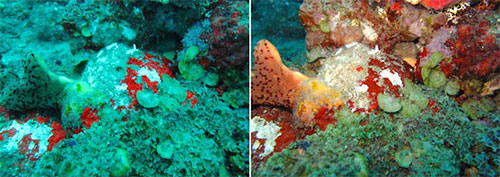
Then there's the interesting phenomenon of fluorescence. Fluorescence essentially describes the physical process of a substance absorbing light at the incoming wavelength, and re-emitting it at a different wavelength. Almost everyone has seen the ghostly effects of "black light" that makes some materials glow brightly while leaving others unaffected. Through scuba I found that there's a totally fascinating world of fluorescence under the sea. I described that in Night Dives Like you've Never Experienced Before.
The image below shows an anemone we photographed with a yellow filter and a NightSea fluorescent protein flashlight. In normal light you'd barely see the animal, but it is strongly fluorescent and lights up under certain incoming wavelengths.
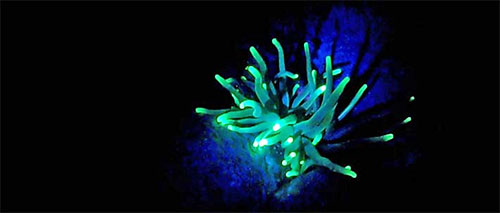
Having founded Digital Camera Magazine in 1998 gave me an opportunity to witness the progression of digital imaging and also the opportunity of hands-on with a large number of different cameras and lenses. That knowledge and experience not only in cameras but also the underlying imaging technologies led to an interest in emerging uses and applications. That included explorations in ultra-slow motion imaging for science projects with my son, and examining the emerging action photography and videography market (it's safe to say that I helped GoPro understand how light behaves underwater; see The GoPro phenomenon: what the world-beating little 1080p vidcam can (and cannot) do).
Below you can see me testing different color filters in a Northern Florida spring with a specially built rig with two GoPro Hero 3 cameras.
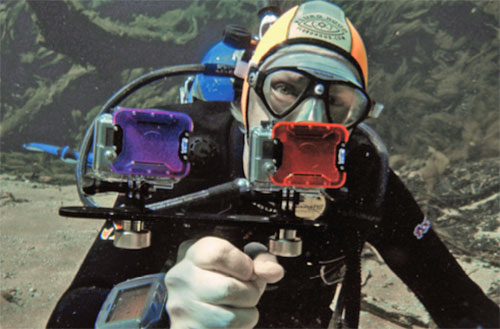
In my work as publisher of RuggedPCReview and before that Editor-in-Chief of Pen Computing Magazine, I came to appreciate thermal modeling and design in microelectronics where proper cooling and removal of heat generated by the processor and related circuitry is among the most important aspects of any mobile computing design.
That's where infrared imaging comes into play. Human eyes and normal cameras cannot see infrared. Older generations will remember that infrared, commonly referred to as IR, was widely used for data communication between computers and devices, and it is still used in many remote controls. Older audiences will also remember the "Predator" movies where those merry human-hunting aliens saw the world in infrared. Infrared, or thermographic, cameras have been available for decades, but at a high price.
Recently, a company named FLIR Systems changed all that with a series of much lower priced thermographic cameras as well as the FLIR One thermal imaging camera module that snaps onto an iPhone or Android device. Not having a review relationship with FLIR, I pre-ordered FLIR One for my iPhone 6 Plus, and it arrived late 2015.
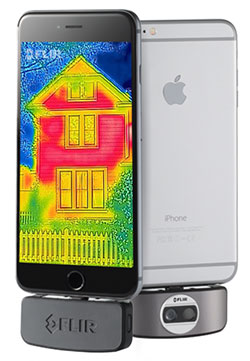 The FLIR One is an absolutely revolutionary product in that it lowers the cost of very functional thermal imaging to around US$250. The way the FLIR One works is that it shoots both a thermal image and a conventional picture. Why the conventional picture? Because thermal imagery doesn't provide much physical detail and it can be difficult for our eyes, unaccustomed to thermal data, to interpret the image. So what the FLIR One does is extract line-drawing type of detail from the conventional image and then merges it with the thermal image. That makes it much easier to exactly see what the thermal data pertains to. The FLIR One does all of that automatically.
The FLIR One is an absolutely revolutionary product in that it lowers the cost of very functional thermal imaging to around US$250. The way the FLIR One works is that it shoots both a thermal image and a conventional picture. Why the conventional picture? Because thermal imagery doesn't provide much physical detail and it can be difficult for our eyes, unaccustomed to thermal data, to interpret the image. So what the FLIR One does is extract line-drawing type of detail from the conventional image and then merges it with the thermal image. That makes it much easier to exactly see what the thermal data pertains to. The FLIR One does all of that automatically.
When you show an IR picture to an uninitiated person, they will almost always assume it's just a Photoshop filter applied to a regular picture. But that's definitely not so. The thermal camera records data readings and then displays those on a color scale. FLIR One users can select from various color schemes. Since most people associate blue with cold and red with hot, I usually use the blue-red scheme.
What can you use the FLIR One for? Well, the applications are almost endless. The architect in me began a thermal imaging review of my home, identifying the efficiency of insulation and the presence of leaks. The scuba diver in me donned full scuba gear and examined hot and cold spots as those can definitely be an issue on a deep cold-water dive. And the reviewer of advanced rugged mobile computing products in me, of course, instantly began examining the thermal properties of gear in our RuggedPCReview testing lab. It's fascinating to see the heat signature of a mobile computing device, how it changes as the device heats up, and get an overall idea of how well the designers and engineers handled the thermal aspects of their products.
Below are some example of images taken with the FLIR One iPhone module. The image on the left shows a heater floating in an iced-over Koi pond. Dark blue is the ice on the surface of the pond, orange and yellow the warmer water kept ice-free by the heater. The image on the right shows the thermal design of a RuggON PX-501 tablet (see our full review). Yellow shows the heat-generating CPU and ancillary circuitry, as well as the copper heat conduit to the fan.
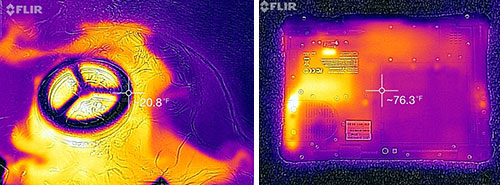
The two pictures below help architects, home owners and contractors. On the left, it's obvious which part of an attic room needs better insulation. On the right, you can literally see the cold air wafting in between two windows on an icy December day.

Is the FLIR One perfect? Not yet. While quadrupling thermal resolution over earlier low-cost efforts, it's still only 160 x 120, far, far less than the typical 8-16 megapixel recorded of the visible light spectrum. You don't need nearly as much resolution to convey useful thermal imagery (640 x 480 is considered high-res) and so the current low res is not a big problem. And now that FLIR has gained a foothold with the FLIR One and similar offerings, we'll likely see higher resolutions very soon.
But my story doesn't end here. In fact, you could say everything above is just an introduction to the news I had wanted to write about, the Cat S60.
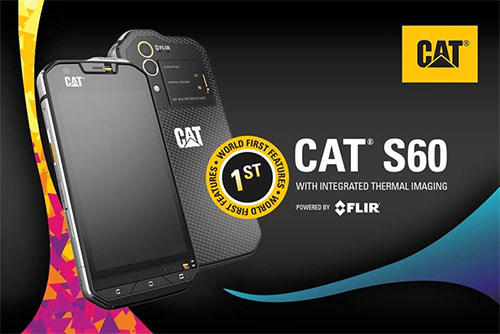
Normally, we consider ourselves pretty well informed about anything in the rugged computing industry, but the Cat S60, officially introduced February 18, caught us by surprise. What is the Cat S60? Cat? Yes, Cat as in Caterpillar! Caterpillar actually sells a line of rugged smartphones on catphones.com. They all look suitably rugged, they all sport the familiar Cat logo, and their design language is reminiscent of Caterpillar's earthmoving machinery.
What immediately came to mind were branded signature edition of rugged hardware, like the "Hummer" version of one of the rugged Itronix notebooks several years ago. So did Caterpillar actually also make smartphones? Not really. Turns out that the Caterpillar phones come courtesy of UK-based Bullitt Group, a privately held technology company that apparently works with a number of tech companies. From what I can tell they either license famous brand names or work in joint ventures. As a result there are JCB phones (JCB is a British heavy equipment manufacturer), Kodak Phones, and Bullitt has even licensed the Marconi brand from Ericsson to launch a range of radios named after the very inventor of radio. Bullitt does about $100 million in sales a year, not tremendous, but very respectable.
What's really interesting, though, is that the Cat S60 is not just a rugged smartphone built to benefit from the Caterpillar image and name. No, it's actually what Bullitt calls "the world's first thermal imaging smartphone" and it has a built-in FLIR imaging camera. So you get thermal imaging built right into your rugged smartphone. The Snapdragon 617 octa-core powered Android Marshmallow phone itself has a bright 540 nits 4.7-inch procap display that can handle wetness and gloves. Ruggedness specs are quite impressive with a 6-foot drop, and what appears to be IP68 sealing. The Cat S60 is said to be waterproof down to 17 feet for an hour, and its 13mp documentation camera can supposedly be used underwater (see Catphones media release).
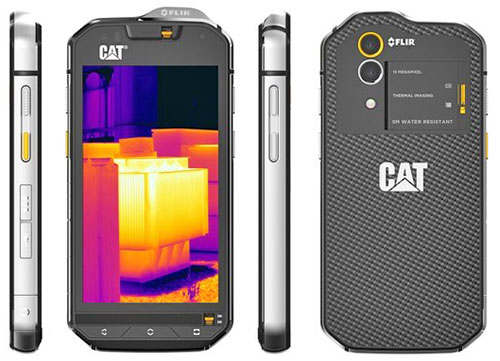
Wow. That is impressive indeed. Having a rugged smartphone with integrated thermal imaging capability opens up entirely new applications and functionality in any number of areas. How is this possible? With FLIR's tiny Lepton longwave infrared sensor that's smaller than a dime. For those interested in all the detail, here's the full FLIR Lepton datasheet in PDF format. Resolution of the initial Lepton imager is limited to 80 x 60 pixel, the same as in FLIR's iPhone 5 camera module, and entirely adequate for thermal imaging on a small smartphone screen. How much does the CAT S60 cost? US$599. Which seems almost too good to be true.
This is all very exciting. I don't know what Caterpillar's reach is in phones, given that we had actually never heard of their phone operation. Then again, I yesterday had a meeting with my landscape architect, and the man had not only heard of, but was very interested in the new Cat S60. I can absolutely see how offering rugged handhelds or tablets with an integrated FLIR Lepton camera can be a strategic advantage, especially if bundled with thermal imaging demos and apps. And having that kind of functionality in a product would not only be of great interest to many customers, but also definitely gold for marketing.
Posted by conradb212 at 3:28 PM
February 15, 2016
Keeping an eye on the level of technology offered in consumer tech: Dell Venue 8
The consumer market is really, really tough. Sure, massive fortunes can be made off it thanks to the sheer size of it, and thus the potential of millions of units sold. But few products ever make it into that sales stratosphere, and the competition is brutal. Make one mistake, be it in technology, manufacturing, marketing or just about anywhere else, and the product tanks, expensively. Add to that the fickle taste of consumers, the unpredictability of trends, a lightening-quick product cycle pace, and the true successes are few and far between. Leaving some very good and often excellent products behind. Or at least underappreciated.
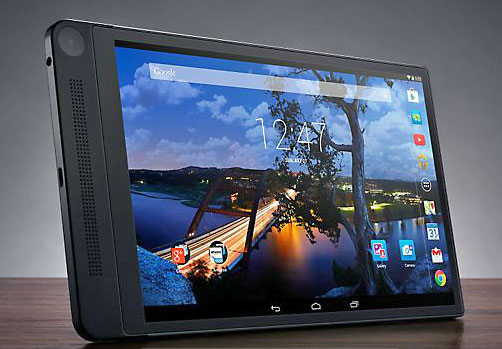
That all came to mind as I spent the weekend playing with my latest impulse buy, a 7000 Series Dell Venue 8 tablet. First available early 2015, the Venue 8 is an 8.4-inch consumer tablet that's part of Dell's efforts to establish itself in mobile technology. That effort had seen the short-lived Dell Venue smartphones and then a re-introduction of the line late 2013 as tablets. Venues tablets are available both in Android as well as Microsoft Windows versions, the latter as the Venue Pro.
So why did I get a Venue tablet? In part because I've always liked Dell. I liked the old Dell Axim handhelds of the Pocket PC era, I like the various rugged Dell tablets and notebooks we've tested here at RuggedPCReview.com, and I liked Dell's decision to take the company private so as not to be at the mercy of Wall Street analysts whose quarterly growth expectations must be met lest they "worry" or, worse, become "concerned."
In this instance, I received an email alerting to a special deal on the Venue 8. I decided to check it out as the trusted Google Nexus 7 I'd been using as my personal small Android tablet, and also as a point of reference whenever we test a rugged Android device, had outlived its usefulness. After the latest OS upgrade — which to Google's credit was always quickly available for the Nexus 7 — the device had become so sluggish as to be useless. Could I not just ask one of our sponsors for a long-term loaner? I could, but I always like to have something that's truly mine and not subject to a sudden unexpected recall for inventory purposes or such.
Add to that that the deal was very sweet. Just US$199 for a 16GB Dell Venue 8 7840 running Android 5.1 (Lollypop). That's $200 off the regular US$399, and shipping included. Fast shipping, too, as the package arrived at my doorstep just a day and a half after I ordered the tablet.
Now, since I am writing this for the RuggedPCReview.com blog, let me make something clear right off the bat: the Venue 8 is NOT a rugged device. It's of the standard consumer/business variety that Dell has always specialized in. So why the write-up if it's not a rugged device? Because it's always good to see what consumer technology is up to and what consumers expect, and get, for their money. With the massive global reach of smartphones and tablets, what consumers expect from their personal gear has a direct impact of what they expect from rugged gear. So there.
If that's the case, and according to our experience it is, then every manufacturer of rugged mobile computing gear should get a Venue 8 and study it. Because consumers get an awful lot of very advanced technology with this tablet, even at its US$399 list price.
First, there is the 8.4-inch display with massive 2,560 x 1,600 pixel resolution. That's 359 pixels per inch and incredibly sharp. It's an OLED (organic light emitting diode) screen that's also vivid with deep blacks and intense colors. The display has absolutely perfect viewing angles from any direction. Brightness ranges, depending on what review you want to believe, from 250 to 430 nits. I consider it very bright. The folks at Anantech actually didn't like the display very much in their review of the Venue 8 (see here). But compared to most displays in rugged devices, it's very, very good.
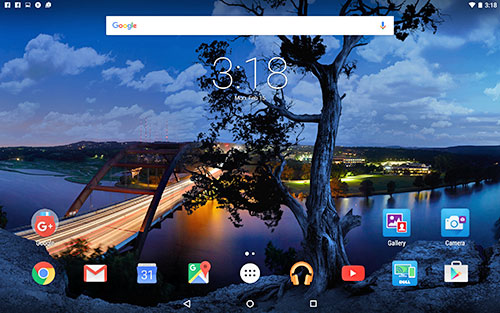
For a processor, the Venue 8 has a quad-core Intel Atom Z3580 with a maximum burst frequency of 2.33GHz. The Z3580 is part of the "Moorefield" lineup of Atom chips and designed specifically for smartphones and tablets. It's different from Bay Trail chips in that it's not using Intel HD Graphics, but a PowerVR Rogue G6430. There's 2GB of RAM and 16GB of eMMC mass storage, plus up to 64GB via externally accessible micro SD card. There's Bluetooth 4.0 and fast 802.11ac WiFi via an Intel 7260 WiFi + BT 4.0 module. And the 21 watt-hour battery is supposed to last 9.5 hours.
The Venue 8 has not just two, but four cameras. Yes four. There is the standard frontal conferencing cam (2mp), there is the 8mp rear-facing documentation camera, and then there are two supplementary 1mp cameras that work in conjunction with the 8mp to allow depth measurement as well as adjusting focus on a picture after it's been taken. You don't see that anywhere else.
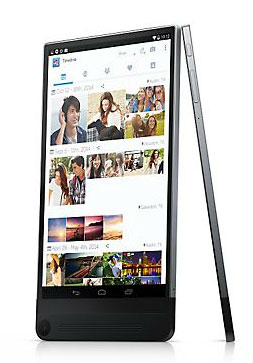
The whole thing is packaged into an anodized aluminum case that measures 8.5 x 4.9 inches and is less than a quarter of an inch thick. This tablet makes the sleek iPhone 6 look a bit stout. Weight is 10.75 ounces.
So how well does the Venue 8 work?
Very well. The Venue 8 has a exceptionally high quality feel to it, in that Apple-esque way that makes it feel like the device is milled from a solid block of metal. And the OLED display is just gorgeous with its rich, vibrant colors and deep blacks. It's like looking at a particularly good Plasma TV compared to regular LCD TV. I/O is minimal. There's the tiny micro-USB jack for charging. There's the micro SD card caddy. A headphone jack. And then the small volume rocker and power switch.
What's a bit unusual is the asymmetrical layout with 3/16th of an inch bezels on three sides and then a much heftier 1-3/16 on the 4th. That's good news for the speakers which get much more real estate than they usually get in a small tablet, and they face forward for good sound. That makes for a largish area where to hold the tablet, but both the front and the rear main cameras are also located there, which means it's easy to inadvertently cover them. Overall, I like the arrangement.
In terms of performance, the Venue 8 is quick. Overall, few of the Android devices that I've tested or worked with are as smooth as anything that comes out of Apple, with a degree of stuttering here and there common. There's very little of that on the Venue 8. It's generally quick and responsive, and a pleasure to use.
Literally billions are familiar with Android now, which means that whatever quirks Android has — and it still has its fair share of them — do not affect its popularity. The vast variety of Android hardware and the numerous versions of Android itself, however, still mean that some apps are either not available for a particular device or version, or they are not optimized for your particular device.
Some reviewers have complained about very small text and icons on the Venue 8 due to its very high resolution on a fairly small display. I did not find this to be an issue under Android Lollipop, and certainly much less of an issue than it is on most small Windows tablets.
The "depth" camera assembly with its main 8mp camera flanked by two 1mp complementary cameras has me baffled. The idea here is that the two subsidiary cameras allow to capture depth information that can then be used to do a variety of things to a picture, like focus on certain areas, applying filters to certain areas, or even measuring distances and areas. It can also be used to widen or narrow the depth of field for artistic purposes.
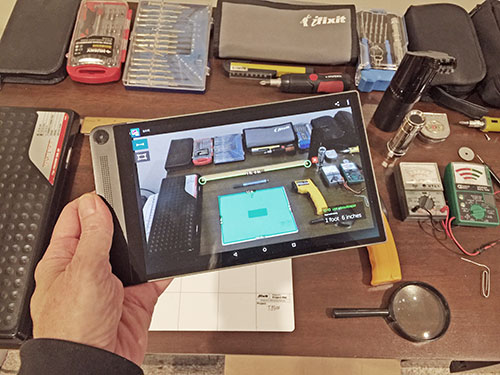
Unfortunately, this is only marginally documented, and didn't work all that well for me. On top, the 8mp camera itself isn't nearly as good as most people have come to expect from their smartphone cameras. So that's a disappointment. It does, however, still work better than most cameras in rugged systems. I understand the need to differentiate a product from the competition, but in this instance I'd have preferred one really excellent documentation camera instead of the triple camera experiment.
Battery life is excellent, especially considering there's only 20 watt-hours, and the device is less than a quarter inch thick. Battery life is so good that, like in iPads, it simply ceases to be an issue.
So what does it all mean as far as rugged computing is concerned? Since it's not a rugged device, nothing directly. However, the Venue 8 demonstrates the level of technology and features that's available to consumers for very little money. And the impressively high quality. The vibrant OLED display with its very high resolution. All for US$399 list, or the ridiculously low US$199 on special.
And what does it mean as far as manufacturers of rugged tablets are concerned? Simply that the consumer market is spoiling consumers with advanced technology that's hard to match in low-volume ruggedized gear with much longer product cycles. So I don't expect to find all this enticing high technology in rugged computing products for the job. But it definitely IS good to keep an eye on what consumers are getting for very little money. Because those consumers then want the same in their professional gear.
Posted by conradb212 at 7:55 PM















